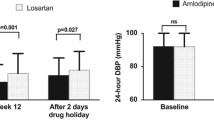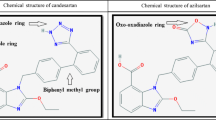Abstract
The efficacy and safety of Iosartan and valsartan were evaluated in a multicenter, double-blind, randomized trial in patients with mild to moderate essential hypertension. Blood pressure responses to once-daily treatment with either losartan 50 mg (n = 93) or valsartan 80 mg (n = 94) for 6 weeks were assessed through measurements taken in the clinic and by 24-hour ambulatory blood pressure monitoring (ABPM). Both drugs significantly reduced clinic sitting systolic (SiSBP) and diastolic blood pressure (SiDBP) at 2, 4, and 6 weeks. Maximum reductions from baseline in SiSBP and SiDBP on 24hour ABPM were also significant with the two treatments. The reduction in blood pressure was more consistent across patients in the losartan group, as indicated by a numerically smaller variability in change from baseline on all ABPM measures, which achieved significance at peak (P = .017) and during the day (P = .002). In addition, the numerically larger smoothness index with losartan suggested a more homogeneous antihypertensive effect throughout the 24-hour dosing interval. The anti hypertensive response rate was 54% with losartan and 46% with valsartan. Three days after discontinuation of therapy, SiDBP remained below baseline in 73% of losartan and 63% of valsartan patients. Both agents were generally well tolerated. Losartan, but not valsartan, significantly decreased serum uric acid an average 0.4 mg/dL at week 6. In conclusion, once-daily losartan 50 mg and valsartan 80 mg had similar anti hypertensive effects in patients with mild to moderate essential hypertension. Losartan produced a more consistent blood pressure-lowering response and significantly lowered uric acid, suggesting potentially meaningful differences between these two A II receptor antagonists.
Similar content being viewed by others
References
Timmermans PBMWM, Carini DJ, Chiu AT, et al. Angiotensin-II receptor antagonists— from discovery to antihypertensive drugs.Hypertension. 1991;18:S136-S142.
Smith RD, Timmermans PBMWM. Ang II receptor antagonists.Pharm News. 1997;4:16–20.
Timmermans PBMWM, Wong PC, Chiu AT, et al. Angiotensin-II receptors and angiotensin-II receptor antagonists.Pharmacol Rev. 1993;45:205–251.
Goa KL, Wagstaff AJ. Losartan potassium—a review of its pharmacology, clinical efficacy and tolerability in the management of hypertension.Drugs. 1996;51:820–845.
Mcintyre M, Caffe SE, Michalak RA, Reid JL. Losartan, an orally active angiotensin (AT(1)) receptor antagonist: a review of its efficacy and safety in essential hypertension.Pharmacol Ther. 1997;74:181–194.
Goldberg AI, Dunlay MC, Sweet CS. Safety and tolerability of losartan compared with atenolol, felodipine and angiotensin converting enzyme inhibitors.J Hypertens. 1995;13(suppl 1):S77-S80.
Smith RD, Cunningham G, Kivlighn SD. Angiotensin II antagonists. In:Emerging Drugs: The Prospect for Improved Medicines. 3rd ed. London, UK: Ashley Publications Ltd. 1998:81–93.
Hedner T, Oparil S, Rasmussen K, et al. A comparison of the angiotensin II antagonists valsartan and losartan in the treatment of essential hypertension.J Hypertens. 1999;12:414–417.
Fogari R, Zoppi A, Mugellini A, et al. Comparative efficacy of losartan and valsartan in mildto-moderate hypertension: results of 24-hour ambulatory blood pressure monitoring.Curr Ther Res Clin Exp. 1999;60:195–206.
Conlin P, Spense JD, Williams B, et al. Angiotensin II antagonists for hypertension: are there differences in efficacy?Am J Hypertens. 2000;13:418–426.
Markham A, Goa KL. Valsartan: a review of its pharmacology and therapeutic use in essential hypertension.Drugs. 1997;54:299–311.
Muller P, Flesch G, deGasparo M, Gasparini M, Howald H. Pharmacokinetics and pharmacodynamic effects of the angiotensin II antagonist valsartan at steady state in healthy, normotensive subjects.Eur J Clin Pharmacol. 1997;52:441–449.
Parati G, Omboni S, Rizzoni D, Agabiti-Rosei E, Mancia G. The smoothness index: a new, reproducible and clinically relevant measure of the homogeneity of the blood pressure reduction with treatment for hypertension.J Hypertens. 1998;16:1685–1691.
Parati G, Rizzoni D, Omboni S, Agabiti-Rosei E, Mancia G. “Smoothness index” but not T/P ratio estimates balanced 24 hour blood pressure control and predicts regression of organ damage by antihypertensive treatment.J Hypertens. 1997;15(suppl 4):S7-S8.
Scholze J, Stapff M. Start of therapy with the angiotensin II antagonist losartan after immediate switch from pretreatment with an ACE inhibitor.Br J Clin Pharmacol. 1998;46:169–172.
Hayashi H. Effect of MK-954 (losartan potassium) on the circadian variation of ambulatory blood pressure—investigation by the periodic analysis of covariance.Ther Res. 1994;15:479–490.
Byyny RL. Losartan potassium lowers blood pressure measured by ambulatory blood pressure monitoring.J Hypertens. 1995;13:S29-S33.
Tedesco MA, Ratti G, Aquino D, et al. Effects of losartan on hypertension and left ventricular mass: a long-term study.J Hum Hypertens. 1998;12:505–510.
Wilson TW, Lacourcière Y, Barnes CC. The antihypertensive efficacy of losartan and amlodipine assessed with office and ambulatory blood pressure monitoring.Can Med Assoc J. 1998;159: 469–476.
Acarturk E, Demir M, Demircan S. Regression of left ventricular hypertrophy with losartan potassium therapy in patients with hypertension.Curr Ther Res Clin Exp. 1998;59:819–825.
Cottone S, Vadala A, Vella MC, et al. Changes of plasma endothelin and growth factor levels, and of left ventricular mass, after chronic AT(l)-receptor blockade in human hypertension.Am J Hypertens. 1998;11:548–553.
Cuspidi C, Lonati L, Sampieri L, et al. Effects of losartan on blood pressure and left ventricular mass in essential hypertension.High Blood Press. 1998;7:11–15.
Dahlöf B, Devereux R, deFaire U, et al. The Losartan Intervention for Endpoint reduction (LIFE) in Hypertension study: rationale, design, and methods.Am J Hypertens. 1997;10:705–713.
Dahlöf B, Devereux RB, Julius S, et al. Characteristics of 9194 patients with left ventricular hypertrophy—the LIFE study.Hypertension. 1998;32:989–997.
Devereux R, Pickering T, Harshfield G, Kleinert H, Denby L, Clark L. Left ventricular hypertrophy in patients with hypertension: importance of blood pressure response to regularly recurrent stress.Circulation. 1983;68:470–476.
Parati G, Ravogli A, Frattola A, et al. Blood pressure variability: clinical implications and effects of antihypertensive treatment.J Hypertens. 1994;12:S35-S40.
Criscione L, Bradley WA, Buhlmayer P, et al. Valsartan: preclinical and clinical profile of an antihypertensive angiotensin-II antagonist.Cardiovasc Drugs Rev. 1999;13:230–250.
Ward HJ. Uric acid as an independent risk factor in the treatment of hypertension.Lancet. 1998; 352:670–671.
Burnier M, Rochramel F, Brunner HR. Renal effects of angiotensin-II receptor blockade in normotensive subjects.Kidney Int. 1996;49:1787–1790.
Shahinfar S, Simpson R, Carides A, et al. Safety of losartan in hypertensive patients with asymptomatic hyperuricemia.J Am Soc Nephrol. 1997;8:A1483.
Rochramel F, Guisan B, Diezi J. Effects of uricosuric and antiuricosuric agents on urate transport in human brush-border membrane vesicles.J Pharmacol Exp Ther. 1997;280:839–845.
Author information
Authors and Affiliations
Rights and permissions
About this article
Cite this article
Monterroso, V.H., Chavez, V.R., Carbajal, E.T. et al. Use of ambulatory blood pressure monitoring to compare antihypertensive efficacy and safety of two angiotensin II receptor antagonists, losartan and valsartan. Adv Therapy 17, 117–131 (2000). https://doi.org/10.1007/BF02854844
Issue Date:
DOI: https://doi.org/10.1007/BF02854844




